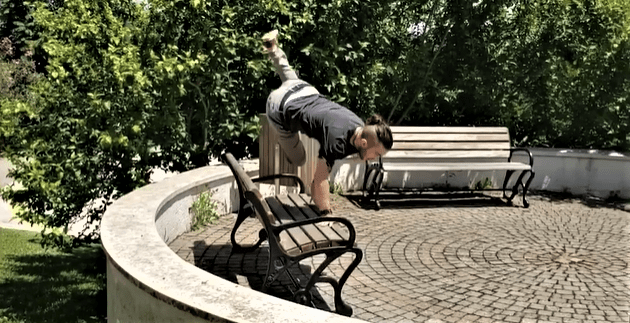Part One: Step Length & Consistency
FOR A SINGLE MOVE
Switch the Start Foot
As long as you are maintaining a consistent step length and starting your run from the same location, you can switch the start foot to change your last step for the movement. This will be helpful for any large single moves that you are working on so that you can eliminate the guesswork and any energy loss.
FOR A SEQUENCE
#1 – Ambidexterity
Ambidexterity is the ability to do use both sides equally. The more comfort you have with different vaults, jumps, rolls, etc. regardless of which side/hand/foot is used, the safer and more smooth you will be for all of your movements. This will eliminate the idea of a “wrong” side unless the environment demands a particular side or if it is a max effort movement. If you train your ambidexterity regularly it can be a great ally in making you a more fluid and well rounded athlete.
The next grouping of tools have to do with altering your step mid run. You can play with these different methods of altering your steps and see which ones make the most sense for your body and the situation. Explore them all so you have a basic level of understanding and can pick the right tool for the job. The most important concept to keep in mind for all of these methods is that they should be done as soon as you become aware of the need for a different step so you can apply the technique and then accelerate into the next movement.
#2 – Big Step
Once you feel and understand that the “wrong” foot is going to be the take off step you can take one or more large steps to get you back on track so that you can continue with minimal energy loss.
#3 – Same Foot Stride
Same concept as the Larger Steps tool, but instead you use a quick same foot stride so that you can reset which foot will be the finishing one. Both these skills are useful for different situations and you may find that you prefer one or the other.
#4 – Two Foot Reset
For this technique you can use a plyo or 2 foot landing to “reset” your steps. This allows you to pick which foot you’d like to use for your next step. Try it instead of a stride or for the landing from a vault to get a feel for where it can fit best into a run.
#5 – Early Stutter Step
You can take your stutter steps immediately after completing one movement so that you are able to accelerate through the remaining In Between with normal steps. This will give you a higher chance of accomplishing the movement/keep the run going than if you were to stutter in the middle or end of the In Between.
General Notes on Steps
Acceleration > Speed
An incredibly important part of keeping your momentum between movements is understanding your controllable level of speed and ensuring there is some acceleration at the end of your in between so that, if your technique is good, you can carry as much of that energy into your next movement as possible. The key here is to pick a speed you can maintain and pump a little more energy out of it when you need for your more powerful movements.
This applies a lot for complex courses where different movements are dictated by the course. For shorter or flatter courses you may be able to sprint the entire time but if you try to keep your absolute top speed the during longer and more varied obstacles it can be more difficult to maintain and you might not have a surplus of energy when needed. This is where understanding the natural rhythm of each movement in your run will help you maintain your speed in a sustainable way.
Tempo Dictates Technique
Each movement has a range of tempos that work most effectively so you will want to verse yourself in the techniques that are best for slow, medium and fast tempos respectively. Some movements, like the step vault, can maintain their effectiveness at many speeds, though the execution may change slightly from one tempo to the next. It’s important for you to explore your movement tool kit and play with these tempos so you can see which ones are most effective for you at various speeds and in different situations.
Steps are just one piece of the fluidity puzzle. Now that you’ve got a grasp on how to improve that part of the in between we will cover how you can use those beautifully smooth steps in your actual movements.
Explore your movement tool kit and play with these tempos so you can see which ones are most effective for you at various speeds and in different situations.

